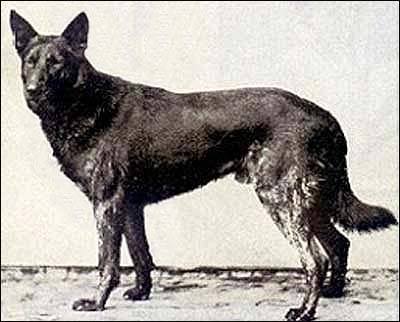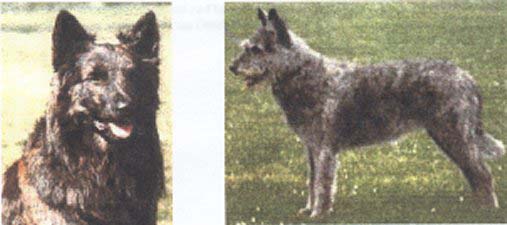
This is a placeholder text
Group text
by neuen Polizei on 31 August 2013 - 15:08
They admit on their page that the father line can't be verified as GSD. If you look at Morzart, he looks like a Dutch Shepherd. Would not surprise me at all if they threw a random Dutchie in with the litter and advertised him as GSD. Most people don't even know what a Dutch Shepherd is. Even the pics of the litter look to be that of a Dutch Shepherd/Malinois cross.
How he has an AKC registration is beyond me as I don't remember brindle being a color option on their forms! I'm sure that "his" DNA will be verified also though, because that's impossible to cheat right?
How he has an AKC registration is beyond me as I don't remember brindle being a color option on their forms! I'm sure that "his" DNA will be verified also though, because that's impossible to cheat right?
by Elkoorr on 31 August 2013 - 23:08
I was thinking the same, a Dutchie slipped in somewhere as Mozart looks very much like one. A cross bred back to a couple GSDs will carry on the brindle, look more like a GSD, and can carry the more dilute colors. The breeder should have tested DNA instead of just testing for the brindle gene on her website.
by Prager on 01 September 2013 - 13:09
Last brindle GSD was surveyed in 1922.
Below is a picture of a brindle GSD(?) from book 'The German Shepherd Dog' by Brian H. Wootton

I wish brindle color would not disappeared. But it should not be recreated by mixing in different breeds,.... which would be easy to do. The dogs in OP look sable to me.
Prager Hans
Below is a picture of a brindle GSD(?) from book 'The German Shepherd Dog' by Brian H. Wootton
I wish brindle color would not disappeared. But it should not be recreated by mixing in different breeds,.... which would be easy to do. The dogs in OP look sable to me.
Prager Hans
by Slamdunc on 01 September 2013 - 14:09
I just looked at their website..........smh 

by kitkat3478 on 01 September 2013 - 15:09
The breeders named as the breeders of these brindle German Shepherds should be required to do a DNA test that verifies the breed, not the color of their dogs before ANY AKC registration papers are issued.
That would seem to me to be a requirement that must be met, prior to the issuance of any registration papers in order to preserve the integrity of the breed, ESPECIALLY when the color is one that is not one readily known to exist within the breed.
That would seem to me to be a requirement that must be met, prior to the issuance of any registration papers in order to preserve the integrity of the breed, ESPECIALLY when the color is one that is not one readily known to exist within the breed.
by Hundmutter on 01 September 2013 - 16:09
Posters might be interested in what Brian Wootton says in relation
to the Survey that this ' lost colour', Brindle dog he reports took part in.
To paraphrase:
Held in 1922, the very first Survey (which was for male dogs only,
incidentally, females would be joined in '23), examined 239 dogs
over the period Feb. to April. While 68 of these had either a Schutzhund
title, or a Police Dog 'title' (PH after their name), and several dogs were
actively in police work, only 4 were herding dogs. In other words
the breed was already moving away from its original use. 67 were
over Standard height (at 66 cm and above). They came from all over
Germany, plus some from Austria and Czech. 25 had "incomplete pedigrees".
Records may still exist for the results*; Brian does not say how many
passed the Survey. Or if the Brindle dog passed it ! Nor does he mention
if any records were kept as to the colour of the dogs - even if they were Brindle
(or Merle, for that matter !) But he does say the records were very detailed,
which does not surprise one about anything the Germans did: "A considerable
amount of information was recorded on each animal, detailing its ancestry, how
it was reared and kept, its performance as a stud dog and its show successes,
together with a complete description of its physical and mental characteristics.
Even its ability in using its nose was tested ..."
The SV / Von Stephanitz published a Survey Book afterwards; maybe replicas
are available ?
to the Survey that this ' lost colour', Brindle dog he reports took part in.
To paraphrase:
Held in 1922, the very first Survey (which was for male dogs only,
incidentally, females would be joined in '23), examined 239 dogs
over the period Feb. to April. While 68 of these had either a Schutzhund
title, or a Police Dog 'title' (PH after their name), and several dogs were
actively in police work, only 4 were herding dogs. In other words
the breed was already moving away from its original use. 67 were
over Standard height (at 66 cm and above). They came from all over
Germany, plus some from Austria and Czech. 25 had "incomplete pedigrees".
Records may still exist for the results*; Brian does not say how many
passed the Survey. Or if the Brindle dog passed it ! Nor does he mention
if any records were kept as to the colour of the dogs - even if they were Brindle
(or Merle, for that matter !) But he does say the records were very detailed,
which does not surprise one about anything the Germans did: "A considerable
amount of information was recorded on each animal, detailing its ancestry, how
it was reared and kept, its performance as a stud dog and its show successes,
together with a complete description of its physical and mental characteristics.
Even its ability in using its nose was tested ..."
The SV / Von Stephanitz published a Survey Book afterwards; maybe replicas
are available ?
by kitkat3478 on 01 September 2013 - 17:09
Beowolf

Beowolf was one of the most used foundation sires of the German Shepherd breed. He was the grandson of SZ1 Horand vom Grafrath. The brindling (referred to at that time as "mottling") is evident on his legs, shoulders, face and if you look closely, even along his ribcage. Eventually breeders went strictly for sables, blacks and black and tans so they bred away from the brindle. A color standard was instated excluding brindle in the mid 1920's. As the Germans began to breed for particular colors, they were breeding away from the Beowolf line and others that carried brindle strong or were brindle themselves. These brindle dogs started to gain popularity in Holland as they were found to have such a strong natural herding instinct. More and more of them crossed over the border and found acceptance, were even sought after. At the same time the Germans were working to eliminate these great herders from their gene pool, the Dutch were working to enlarge their number and were obtaining all of them they could from Germany. If it hadn't been for the desire of the Dutch to own the brindle shepherd, no doubt it would have been bred completely out of existance, as were the spotted and wirehaired shepherd dogs that were such a large contriubtor to the making the GSD. The Dutch Shepherd has three hair coat types, the short coat (above), the long coat and the rough coat pictured below


Beowolf was one of the most used foundation sires of the German Shepherd breed. He was the grandson of SZ1 Horand vom Grafrath. The brindling (referred to at that time as "mottling") is evident on his legs, shoulders, face and if you look closely, even along his ribcage. Eventually breeders went strictly for sables, blacks and black and tans so they bred away from the brindle. A color standard was instated excluding brindle in the mid 1920's. As the Germans began to breed for particular colors, they were breeding away from the Beowolf line and others that carried brindle strong or were brindle themselves. These brindle dogs started to gain popularity in Holland as they were found to have such a strong natural herding instinct. More and more of them crossed over the border and found acceptance, were even sought after. At the same time the Germans were working to eliminate these great herders from their gene pool, the Dutch were working to enlarge their number and were obtaining all of them they could from Germany. If it hadn't been for the desire of the Dutch to own the brindle shepherd, no doubt it would have been bred completely out of existance, as were the spotted and wirehaired shepherd dogs that were such a large contriubtor to the making the GSD. The Dutch Shepherd has three hair coat types, the short coat (above), the long coat and the rough coat pictured below

Contact information Disclaimer Privacy Statement Copyright Information Terms of Service Cookie policy ↑ Back to top




